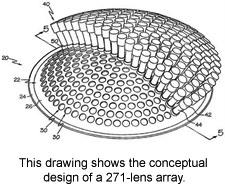GigaPixel Camera brings vast “improvement” for surveillance
If you enjoy being
watched?

Researchers at The University of Alabama in Huntsville have developed a wide-angle camera that will be able to provide security forces with the ability to monitor large areas through high-resolution images taken from a satellite or an airborne craft.
It was David Pollock who first discovered that if you point a large number of lenses toward a common point, and then make a small correction on each of the lenses, you provide a camera with capabilities that far surpass existing technologies.
Ultimately the camera can cover nearly a hemispherical field-of-view with uniform image quality and sensitivity. The initial camera design constraint was to obtain greater than 109 samples within a 10 x 10 km ground footprint. It was quickly realized that with 4 mega-samples (mega-pixel) per camera this would require 271 cameras. The constraint leads to significant, greater than 90 percent sample redundancy.
Reducing the redundancy to less than 1 percent significantly expands the field-of-view, Pollock said. Further, because of the modular nature, the field-of-view can be configured to suit specific applications.
UAHuntsville filed the patent for the large-format giga-pixel camera and shares that patent on a 50-50 basis with Sony.
Cripes. Probably uses a yardstick-sized memory stick.
Posted: Fri - March 14, 2008 at 01:43 PM